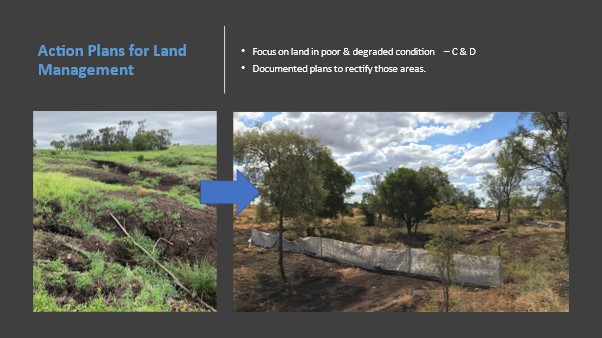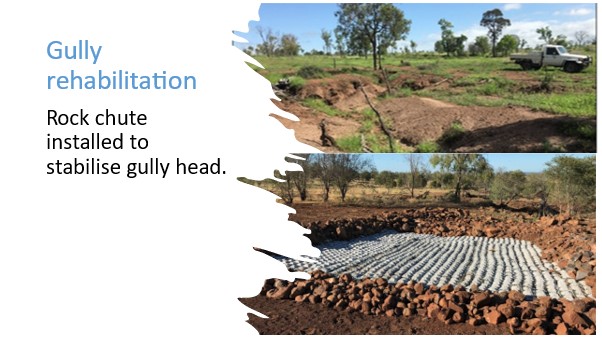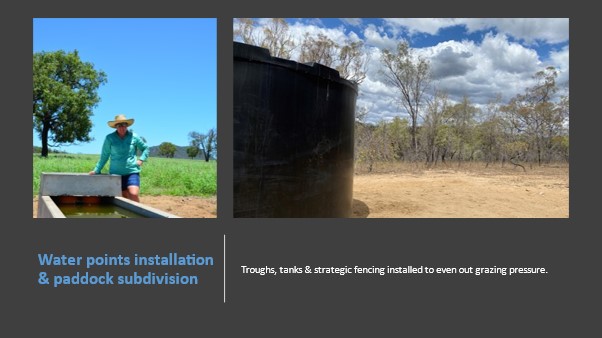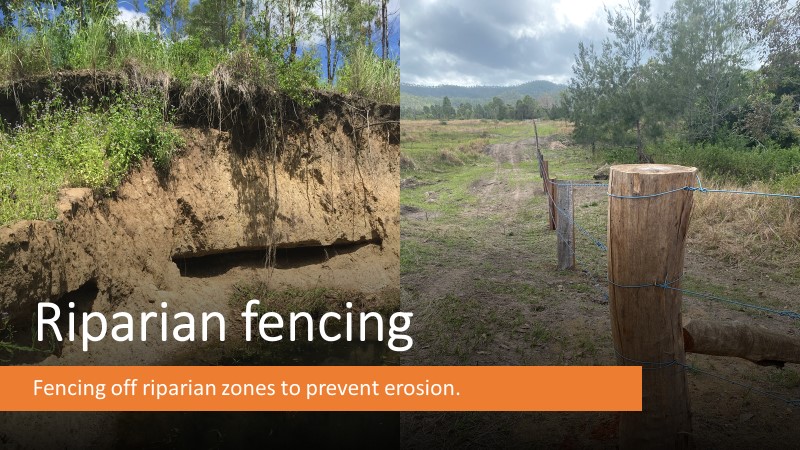GRASS – adding value to your grazing asset
The Grazing Resilience and Sustainable Solutions (GRASS) program has made huge headway in the remediation of grazing country in poor (C) or degraded (D) land condition.
GRASS has a focus on improving land condition, productivity, sustainability and profitability on grazing properties.
The program supports graziers to develop and implement tailor-made action plans for land management. These action plans provide graziers with the latest tools and information to identify, improve and maintain their land condition with a specific focus to improve ground cover and reduce soil loss from their property. Incentive funds associated with the GRASS project administered through the NRM groups; Fitzroy Basin Association, NQ Dry Tropics and Burnett Mary Regional Group have contributed to property owners making management changes.
Recently, an action plan was completed for a property near Banana. It identified a large gully that needed attention. The gully system had formed on a black soil area that ran across three paddocks, requiring action to prevent further spread.
Historic ground cover maps and records confirmed that previously, large areas on these paddocks had been both over, and under, grazed. The black cracking clay naturally formed gilgais which had eroded over time in the over grazed areas.
In recent years, better grazing management and the installation of new infrastructure (fencing and waters) has decreased the rate at which the gully heads were moving, but more work was needed to spread grazing pressure and remediate the gullies. Many wire weirs were installed in the gully to stabilise it – these are displayed in the photos below.

On another property in the Banana area three large gully systems had formed in three separate paddocks. Extreme weather events in recent years exacerbated the rate at which these gully systems had expanded, causing significant soil loss. Consistent efforts have been made to manage the stocking rates of these three paddocks to limit the amount of cattle disturbance/traffic around these gullies.
An action plan developed for this property identified that further mechanical remediation techniques were needed to divert water run-off and halt the spread of these gullies.
In response, a rock chute was installed at the head of one gully to channel the water into a single point and reduce the spread of the gully head and subsequent soil loss. In addition, contour ripping and grass seeding of the 15ha catchment feeding this gully was also completed, to further slow the volume and velocity of water running into the diversion banks reducing the water load and strain taken on by the rock chute and minimising soil run-off from the area.

In Yeppoon, cattle were favouring certain areas of paddocks on a property. This led to an increase in less desirable grass species such as Paramatta and Giant Rats Tail. Following the development of an action plan for the area, land management improvements were made, including subdividing paddocks to enable greater control of grazing pressure. The creation of new paddocks provided the opportunity to grow more productive pastures.
Better management of grazing pressure combined with spelling will lead to higher pasture biomass and ground cover at the end of the dry season, which will help to reduce runoff. Creation of additional paddocks will assist grazing management across the property and enable greater use of a wet season spelling strategy.
Other properties with mountainous areas, can experience uneven pasture utilization, as cattle favour the low-lying areas of the topography, rather than feeding in mountainous areas. There can be areas of the property with large bodies of grass, where cattle don’t venture. To increase utilization of these areas water infrastructure can be installed to encourage cattle to stay longer and ensure grazing pressure is evened out.
There has been a lot of interest from graziers in installing riparian fencing under the GRASS incentives program. Several property managers have implemented fencing on their properties to prevent further erosion in riparian areas, often caused by cattle drinking from natural water sources. Water points were installed away from the riparian zones before they were fenced off.
The GRASS program is dedicated to improving and maintaining the value of grazing land. Action plans for land management are living documents that need to be continually reviewed to ensure that written goals and strategies are achieving desired outcomes.
Graziers in the Burdekin, Fitzroy and Burnett Mary regions can apply to participate in the GRASS program by calling Department of Agriculture and Fisheries on 13 25 23 or by contacting their local participating Natural Resource Management (NRM) group or extension officer.

